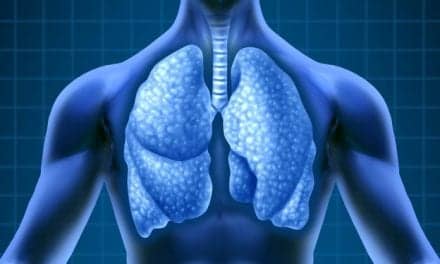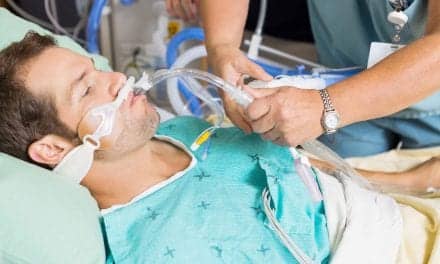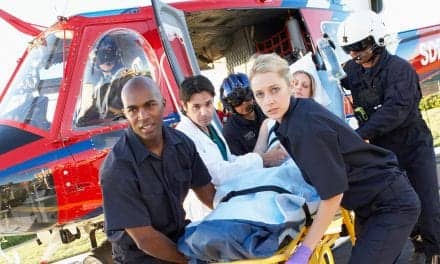The respiratory care department at Craig Hospital (Denver, CO) has one overarching goal: get its patients back home to their families and their lives.
By Alison Werner
Located in Denver, Craig Hospital is a small, 93-bed acute care and rehabilitation hospital providing inpatient and outpatient medical care, rehabilitation, and long-term follow-up services to spinal cord injury (SCI) and traumatic brain injury (TBI) patients. Founded in 1907 as a tuberculosis center, Craig turned its focus to rehabilitation of catastrophic injury patients in 1956. Since then, Craig has treated more than 26,000 patients, and more patients with SCI than any other hospital in the world.
Yearly, Craig treats approximately 200 newly injured SCI patients, 100 newly injured TBI patients, and more than 1,600 outpatients. Ranked in the Top Ten Rehabilitation Hospitals in the United States for 21 consecutive years by U.S. News and World Report, Craig can boast that 92.5% of its patients who remain ventilator-dependent are discharged to their homes rather than subacute facilities or nursing homes. Lonnie Martinez, director of the respiratory care department, attributes this success rate to the culture of both the facility and the respiratory care department.
“We place a heavy emphasis on the discharge disposition throughout the patient’s course. It’s absolutely our goal—not just within the respiratory care department, but hospital wide—to discharge the patient home,” says Martinez. “We prepare the patient for their life after their hospital stay. Our former CEO used to say that ‘Craig Hospital is a dress rehearsal for the rest of the patient’s life.’ We partner with the patient for their success.”
Up to the Task
Like any nonspecialty hospital, Craig’s RTs see the usual respiratory conditions—from COPD to asthma. The difference is that these conditions must be managed from the perspective of the patient’s catastrophic injury.
“As a respiratory therapist [at Craig], you’re hired with a general knowledge related to managing sleep apnea, asthma, or whatever disease, etc. But here at our facility, our patients have all those things; in addition, they have a catastrophic injury that neurologically decreases inspiratory volumes. Our patients’ vital capacities are tremendously decreased, and their expiratory flow rates are greatly altered. We have to employ strategies that assist our patients’ ability to breathe deeply and exhale forcefully,” says Martinez.
As a result, Craig’s RTs have to build a program that is specific to each and every patient based on their injury and any underlying comorbid issue. And that program can change every single day, requiring the department’s RTs to be heavily involved in the decision-making related to the patient’s pulmonary care. It also requires the department’s RTs to be what Martinez calls “thinking therapists” who are goal oriented and not task driven.
As Brigitte Trace, RRT, a respiratory therapist at Craig, explains it, “When we get a patient admitted, we look at what we’re dealing with and what our goals are for this patient—do they have the ability to get off the vent? If not, how are we going to train them to live like this? How are we going to train their family to live like this? What are our short-term goals? What are our long-term goals? We don’t just come in and look at the orders and do our thing.”
Against the Grain
One goal the RTs at Craig often find themselves trying to achieve is getting a patient off mechanical ventilation. For many Craig patients, whether it be temporary or permanent, full-time or part-time, mechanical ventilation is often necessary to manage respiratory failure. With one of the largest specialty programs in the country, Craig has established a reputation for success at weaning patients off ventilators, a completely protocol-driven program managed entirely by the respiratory care department’s RTs.
A component of this effort is Craig’s high tidal volume protocol, which definitely goes against the grain. Craig’s protocol calls for increasing tidal volumes up to 20 ml/kg of ideal body weight to improve functional residual capacity. This method helps clear atelectasis and consolidated lung tissue and assists with weaning SCI patients from mechanical ventilation and reducing other pulmonary complications associated with such injury.
“It’s definitely opposite of what we learned through ARDSNet,” says Martinez. “What we’ve found is that with subacute spinal injury, optimal tidal volumes are much larger. We employ a systematic high volume strategy that helps us manage patients from a secretion proliferation perspective, improving atelectasis and decreasing Fio2 requirements on the ventilator. In essence, we use high tidal volumes as a lung recruitment strategy. We simply don’t see all of the catastrophic problems associated with high tidal volumes that you read about. Again, these are subacute patients who don’t have ARDS. Since their lungs are typically not injured, we’re not as concerned with inducing ventilator-related injury.”
The satisfaction of successfully weaning a patient from mechanical ventilation is felt throughout the department.
“You can imagine what it feels like. The first time you give someone their voice—maybe they haven’t been able to talk to their family in a month or two, it’s pretty amazing,” says Trace.
“I had a patient who was here on his own. His family was coming, but they hadn’t arrived yet. He was making progress—leaps and bounds—but he hadn’t spoken in probably 2 or 3 months. We were able to put a speaking valve on. I went and got my cell phone and we called his mom and left a message on her answering machine. She called back within an hour just bawling—we all started crying. It’s an unreal place. Every day there are small rewards.”
Liberation
In recent years, Craig has added another tool to its arsenal to achieve its goal of getting patients home, and even liberated from mechanical ventilation. Since 2008, Craig has employed Synapse Biomedical’s NeuRx™ diaphragmatic pacing system—a minimally invasive alternative to mechanical ventilation. The diaphragmatic pacing program offers ventilator-dependent patients the possibility of ventilator liberation for certain periods of time, as well as increased independence and a reduced risk of respiratory complications. As Martinez puts it, the diaphragm pacing program is a “new twist on an old philosophy.”
“There’s been phrenic nerve pacing around for decades, but this is a little bit different in that we implant the patients at the motor point on the underside of the diaphragm,” says Martinez.
For the laparoscopic procedure, surgical staff map out the diaphragm to find the motor point for the phrenic nerve—the point where stimulation will cause the maximum contraction of the diaphragm, creating a more natural form of breathing. Once identified, the device is implanted.
Like the weaning program, the RTs run the program from top to bottom. Once the patient is out of surgery, the RTs are responsible for the conditioning process to rehabilitate the patient’s diaphragm. And conditioning starts within hours of surgery.
Conditioning focuses on regaining the diaphragm’s strength and endurance to reverse the effects of atrophy. During a conditioning session, RTs will wean the patient, taking them off mechanical ventilation, and turning on the diaphragmatic pacer. The RTs try to optimize all of the settings to ensure that a patient’s hemodynamics and acid-base balance are stabilized. A patient’s volumetric CO2 and oxygenation are also monitored. The patient’s diaphragm is worked until it is fatigued—when all the signs of respiratory failure appear. Once that point is reached, the pacer is turned off, the patient is placed back on their mechanical ventilator, and the diaphragm is allowed to rest like any other muscle being worked out, but that rest is short.
“It’s amazing because the diaphragm will recover so fast that you can take it to complete failure and then give it just an hour rest and then it’s ready to go again,” says Martinez.
If successful, the patient’s mechanical ventilator, battery, cables, and tubing can be replaced with a diaphragm pacer box that measures 6 inches tall, 3 inches wide, and 1½ inches deep.
Since the program’s implementation at Craig, 16 patients have received the diaphragmatic pacer implant. But it is Craig’s first diaphragmatic pacing patient that Martinez calls the hospital’s best success story.
“This was a patient who was catastrophically injured, ventilator dependent, with no volitional ability to breathe at all,” he recalls. “Within 7 days, this patient was completely mechanical ventilator free.”
More recent successes include a female patient, who had some accessory muscle use and was thus able to be ventilator free during the day, but relied on a ventilator during the night, otherwise she would go apneic. Within 2 weeks of undergoing the diaphragmatic pacer procedure, this patient was off the ventilator.
“I saw her in our clinic just a couple of days ago, and she is 100% ventilator free,” says Martinez. “She asked me if she could be in the commercial when we go to market this program.”
Such success amazes RTs like Justin Walter, RRT. “You get to see people who would never get off a ventilator, or are told you will never breathe without this machine, able to get off of it. It’s amazing to see that,” says Walter.
Continuum of Care
All these procedures go a long way in Craig’s success at getting patients home and back living their lives. But education for both the patient and the patient’s family and caregivers, starting the day the patient is admitted, also plays a vital role in a patient’s success.
“If the family is successful in learning the patient’s care, then we feel strongly that the patient is going to be successful,” says Martinez.
And the relationship with a patient does not end at discharge. Craig prides itself on a continuum of care that often begins prior to admission and extends well after discharge. Prior to admission, RTs work with the admissions department visiting referring facilities to do patient assessments, allowing the respiratory care department to get started on a patient’s respiratory treatment plan before the patient even arrives. When discharge finally comes, the respiratory care department’s involvement continues. Within 1 week of discharge, a patient who was receiving respiratory services at the time of discharge will receive a telephone call from an RT to see how they are doing. At a minimum, an RT will follow up again at the 1-month mark, and then again at the 6-month mark, to make sure patients are following their asthma action plan, utilizing their noninvasive ventilator to optimize their sleep apnea, or using their cough assist to keep their secretions clear and their lungs healthy. Throughout, says Martinez, the goal is to decrease recidivism and ensure patient success.
And as Trace puts it, “Even if you leave Craig, you don’t leave the family. It sounds like the mob, but once you’re in, you’re in for life.”
RT
Alison Werner is associate editor for RT. For further information, contact [email protected].










